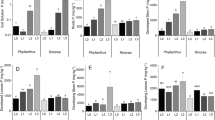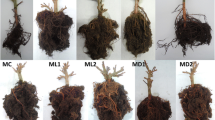Abstract
Aims
The effects of waterlogging on redox state and solubility of antimony (Sb) in a calcareous shooting range soil and its uptake by forage grass Lolium perenne L. and pasture weed Holcus lanatus L. were investigated.
Methods
Grasses were grown on semi-waterlogged or waterlogged shooting range soil in a laboratory tank. The soil solution was sampled at various depths over time and analyzed for the concentrations of Sb(III), Sb(V) and total Sb, as well as other trace elements.
Results
Although the reduction of Sb(V) to Sb(III) under increased waterlogging time decreased Sb solubility, it increased Sb uptake by L. perenne from 1.1 to 1.7 mg kg−1 (and to a lesser extent H. lanatus), implying preferential uptake of Sb(III) by this grass. The tank showed considerable variation in redox conditions with depth and plant treatment. The soil root zone (30 cm for L. perenne and 15 cm for H. lanatus) instead of the water saturated bottom, showed the highest manganese (Mn) and iron (Fe) concentrations in solution, accompanied by a higher proportion of Sb(III) in solution than the bottom zone of the tank.
Conclusions
Waterlogging can increase the risk of Sb entering the food chain from shooting range soil.






Similar content being viewed by others
References
Arai Y (2010) Arsenic and antimony. In: Hooda PS (ed) Trace elements in soils. Wiley-Blackwell, London, pp 384–400
Audet P, Charest C (2010) Identification of constraining experimental-design factors in mycorrhizal pot-growth studies. J Bot 2010:1–6. doi:10.1155/2010/718013
Bannon DI, Drexler JW, Fent GM, Casteel SW, Hunter PJ, Brattin WJ, Major MA (2009) Evaluation of small arms range soils for metal contamination and lead bioavailability. Environ Sci Technol 43(24):9071–9076. doi:10.1021/es901834h
Baroni F, Boscagli A, Protano G, Riccobono F (2000) Antimony contents in plant species growing in an Sb-mining district (Tuscany, Italy). In: Markert B, Friese K (eds) Trace metals in the environment, vol 4. Elsevier, pp 341–361
Belzile N, Chen YW, Wang ZJ (2001) Oxidation of antimony (III) by amorphous iron and manganese oxyhydroxides. Chem Geol 174(4):379–387. doi:10.1016/s0009-2541(00)00287-4
Bienert GP, Thorsen M, Schussler MD, Nilsson HR, Wagner A, Tamas MJ, Jahn TP (2008) A subgroup of plant aquaporins facilitate the bi-directional diffusion of As(OH)3 and Sb(OH)3 across membranes. BMC Biol 6:26. doi:10.1186/1741-7007-6-26
Bowen GD, Rovira A (1991) The rhizosphere. In: Walsel Y, Eshel A, Kafkafi U (eds) Plant roots, the hidden half. Marcel Dekker, New York, pp 641–669
BUWAL (2005) Gefährdungsabschätzung und Massnahmen bei schadstoffbelasteten Böden. Bundesamt für Umwelt, Wald und Landschaft. Bern
Cao XD, Ma LQ, Chen M, Hardison DW, Harris WG (2003) Lead transformation and distribution in the soils of shooting ranges in Florida, USA. Sci Total Environ 307(1–3):179–189. doi:10.1016/s0048-9697(02)00543-0
Cheng JM, Wong MH (2008) Effects of earthworm (Pheretima SP.) on three sequential ryegrass harvests for remediating Lead/Zinc mine tailings. Int J Phytorem 10(3):173–184
Comino E, Menegatti S, Fiorucci A, Schwitzguebel JP (2011) Accumulation and translocation capacity of As, Co, Cr and Pb by forage plants. Agrochimica 55(2):105–115
Conesa HM, Wieser M, Gasser M, Hockmann K, Evangelou MWH, Studer B, Schulin R (2010) Effects of three amendments on extractability and fractionation of Pb, Cu, Ni and Sb in two shooting range soils. J Hazard Mater 181:845–850
Conesa HM, Wieser M, Studer B, Schulin R (2011) Effects of vegetation and fertilizer on metal and Sb plant uptake in a calcareous shooting range soil. Ecol Eng 37(4):654–658. doi:10.1016/j.ecoleng.2010.11.001
Cornelis G, Johnson CA, Van Gerven T, Vandecasteele C (2008) Leaching mechanisms of oxyanionic metalloid and metal species in alkaline solid wastes: a review. Appl Geochem 23(5):955–976. doi:10.1016/j.apgeochem.2008.02.001
Council of the European Communities (1998) Council Directive 98/83/EC of 3 November 1998 on the quality of water intended for human consumption
Elinder CG, Friberg L (1986) Antimony. In: Friberg L, Nordberg GF, Vouk V (eds) Handbook on the toxicity of metals, 2nd edn. Elsevier Science Publication, New York, pp 353–365
Everaarts AP, van Beusichem ML (1998) The effect of planting date and plant density on potassium and magnesium uptake and harvest by Brussels sprouts. J Agron Crop Sci 181(4):201–207
Filella M, Belzile N, Lett MC (2007) Antimony in the environment: a review focused on natural waters. III. Microbiota relevant interactions. Earth Sci Rev 80(3–4):195–217
Filella M, Williams PA, Belzile N (2009) Antimony in the environment: knowns and unknowns. Environ Chem 6(2):95–105. doi:10.1071/en09007
Gebel T (1997) Arsenic and antimony: comparative approach on mechanistic toxicology. Chem Biol Interact 107(3):131–144
Gonzaga MIS, Santos JAG, Ma LQ (2008) Phytoextraction by arsenic hyperaccumulator Pteris vittata L. from six arsenic-contaminated soils: repeated harvests and arsenic redistribution. Environ Pollut 154(2):212–218
Griggs CS, Martin WA, Larson SL, O'Connnor G, Fabian G, Zynda G, Mackie D (2011) The effect of phosphate application on the mobility of antimony in firing range soils. Sci Total Environ 409(12):2397–2403. doi:10.1016/j.scitotenv.2011.02.043
Hammel W, Debus R, Steubing L (2000) Mobility of antimony in soil and its availability to plants. Chemosphere 41(11):1791–1798. doi:10.1016/s0045-6535(00)00037-0
Hanson PJ, Sucoff EI, Markhart AH (1985) Quantifying apoplastic flux through red pine root systems using trisodium, 3-hydroxy-5,8,10-pyrenetrisulfonate. Plant Physiol 77:21–24
He MC, Yang JR (1999) Effects of different forms of antimony on rice during the period of germination and growth and antimony concentration in rice tissue. Sci Total Environ 244:149–155
Hinsinger P, Plassard C, Tang C, Jaillard B (2003) Origins of root-mediated pH changes in the rhizosphere and their responses to environmental constraints: a review. Plant Soil 248(1):43–59. doi:10.1023/a:1022371130939
Huang C, Webb MJ, Graham RD (1996) Pot size affects expression of Mn efficiency in barley. Plant Soil 178(2):205–208. doi:10.1007/bf00011584
Inglett PW, Reddy KR, Corstanje R (2005) Anaerobic soils. In: Daniel H (ed) Encyclopedia of soils in the environment. Elsevier, Oxford, pp 72–78
Johnson CA, Moench H, Wersin P, Kugler P, Wenger C (2005) Solubility of antimony and other elements in samples taken from shooting ranges. J Environ Qual 34(1):248–254
Kamiya T, Fujiwara T (2009) Arabidopsis NIP1;1 transports antimonite and determines antimonite sensitivity. Plant Cell Physiol 50(11):1977–1981
Kirsch R, Scheinost AC, Rossberg A, Banerjee D, Charlet L (2008) Reduction of antimony by nano-particulate magnetite and mackinawite. Mineral Mag 72(1):185–189. doi:10.1180/minmag.2008.072.1.185
Laporte-Saumure M, Martel R, Mercier G (2011) Characterization and metal availability of copper, lead, antimony and zinc contamination at four Canadian small arms firing ranges. Environ Technol 32(7):767–781. doi:10.1080/09593330.2010.512298
Leuz AK, Hug S, Moench H, Wehrli B, Johnson CA (2002) The redox chemistry of antimony in lakes. Geochim Cosmochim Acta 66(15A):A450
Leuz AK, Hug SJ, Wehrli B, Johnson CA (2006) Iron-mediated oxidation of antimony(III) by oxygen and hydrogen peroxide compared to arsenic(III) oxidation. Environ Sci Technol 40(8):2565–2571. doi:10.1021/es052059h
Lewis J, Sjostrom J, Skyllberg U, Hagglund L (2010) Distribution, chemical speciation, and mobility of lead and antimony originating from small arms ammunition in a coarse-grained unsaturated surface sand. J Environ Qual 39(3):863–870. doi:10.2134/jeq2009.0211
Lin Z (1996) Secondary mineral phases of metallic lead in soils of shooting ranges from Örebro County, Sweden. Environ Geol 27(4):370–375. doi:10.1007/bf00766707
Logoteta B, Xu XY, Macnair MR, McGrath SP, Zhao FJ (2009) Arsenite efflux is not enhanced in the arsenate-tolerant phenotype of Holcus lanatus. New Phytol 183(2):340–348. doi:10.1111/j.1469-8137.2009.02841.x
Massmann G, Nogeitzig A, Taute T, Pekdeger A (2008) Seasonal and spatial distribution of redox zones during lake bank filtration in Berlin, Germany. Environ Geol 54(1):53–65
Mathys R, Dittmar J, Johnson A (2007) Antimony in Switzerland: a substance flow analysis. The Swiss Federal Office for the Environment (FOEN), Bern
Miao SY, DeLaune RD, Jugsujinda A (2006) Influence of sediment redox conditions on release/solubility of metals and nutrients in a Louisiana Mississippi River deltaic plain freshwater lake. Sci Total Environ 371(1–3):334–343. doi:10.1016/j.scitotenv.2006.07.027
Migliorini M, Pigino G, Bianchi N, Bernini F, Leonzio C (2004) The effects of heavy metal contamination on the soil arthropod community of a shooting range. Environ Pollut 129(2):331–340. doi:10.1016/j.envpol.2003.09.025
Mitsunobu S, Harada T, Takahashi Y (2006) Comparison of antimony behavior with that of arsenic under various soil redox conditions. Environ Sci Technol 40(23):7270–7276. doi:10.1021/es060694x
Mitsunobu S, Takahashi Y, Sakai Y (2008) Abiotic reduction of antimony(V) by green rust (Fe4(II)Fe2(III)(OH)12SO4.3H2O). Chemosphere 70(5):942–947. doi:10.1016/j.chemosphere.2007.07.021
Mitsunobu S, Takahashi Y, Terada Y (2010) mu-XANES evidence for the reduction of Sb(V) to Sb(III) in soil from Sb mine tailing. Environ Sci Technol 44(4):1281–1287. doi:10.1021/es902942z
Moon GJ, Clough BF, Peterson CA, Allaway WG (1986) Apoplastic and symplastic pathways in Avicennia marina (Forsk.) Vierh. Roots revealed by fluorescent tracer dyes. Aust J Plant Physiol 13:637–648
Nardi S, Concheri G, Pizzeghello D, Sturaro A, Rella R, Parvoli G (2000) Soil organic matter mobilization by root exudates. Chemosphere 41(5):653–658. doi:10.1016/s0045-6535(99)00488-9
Norrstrom AC (1994) Field-measured redox potentials in soils at the groundwater surface-water inferface. Eur J Soil Sci 45(1):31–36. doi:10.1111/j.1365-2389.1994.tb00483.x
Phillips IR (1999) Copper, lead, cadmium, and zinc sorption by waterlogged and air-dry soil. J Soil Contam 8(3):343–364
Ramanathan S, Shi WP, Rosen BP, Daunert S (1997) Sensing antimonite and arsenite at the subattomole level with genetically engineered bioluminescent bacteria. Anal Chem 69(16):3380–3384. doi:10.1021/ac970111p
Ray JD, Sinclair TR (1998) The effect of pot size on growth and transpiration of maize and soybean during water deficit stress. J Exp Bot 49(325):1381–1386. doi:10.1093/jexbot/49.325.1381
Reid BJ, Watson R (2005) Lead tolerance in Aporrectodea rosea earthworms from a clay pigeon shooting site. Soil Biol Biochem 37(3):609–612. doi:10.1016/j.soilbio.2004.09.003
Scheinost AC, Rossberg A, Vantelon D, Xifra I, Kretzschmar R, Leuz AK, Funke H, Johnson CA (2006) Quantitative antimony speciation in shooting-range soils by EXAFS spectroscopy. Geochim Cosmochim Acta 70(13):3299–3312. doi:10.1016/j.gca.2006.03.020
Sorvari J (2007) Environmental risks at Finnish shooting ranges—a case study. Hum Ecol Risk Assess 13(5):1111–1146. doi:10.1080/10807030701506124
Stømseng A, Ljønes M (2000) Vertikal transport av tungmetaller i sandjord. Mobilitet, transport og fordeling av bly, kobber, antimon og sink i jordsmonn tilknyttet en 30 m utendørs skytebane på Sessvollmoen. FFI Rapport-2000/06191. http://rapporter.ffi.no/rapporter/2000/06191.pdf accessed 03.05.2012
Sundar S, Chakravarty J (2010) Antimony toxicity. Int J Env Res Public Health 7(12):4267–4277. doi:10.3390/ijerph7124267
Takahashi T, Shozugawa K, Matsuo M (2010) Contribution of amorphous iron compounds to adsorptions of pentavalent antimony by soils. Water Air Soil Pollut 208(1–4):165–172. doi:10.1007/s11270-009-0156-z
The Swiss Federal Council (1998) Ordinance relating to impacts on the soil of the Swiss Federal Council, 1st of July 1998, SR 814.12. Eidgenössische Drucksachen- und Materialzentrale, Bern, p 12
Thomas CR, Miao S, Sindhoj E (2009) Environmental factors affecting temporal and spatial patterns of soil redox potential in Floriada Everglades wetlands. Wetlands 29(4):1133–1145
Tighe M, Ashley P, Lockwood P, Wilson S (2005) Soil, water, and pasture enrichment of antimony and arsenic within a coastal floodplain system. Sci Total Environ 347(1–3):175–186
Tschan M, Robinson BH, Nodari M, Schulin R (2009) Antimony uptake by different plant species from nutrient solution, agar and soil. Environ Chem 6(2):144–152. doi:10.1071/en08103
Turkington R, Harper JL (1979) The growth, distribution and neighbour relationships of Trifolium Repens in a permanent pasture: I. Ordination, pattern and contact. J Ecol 67(1):201–218
USEPA (1979) Water related fate of the 129 priority pollutants. Vol 1. United States Environmental Protection Agency, Washington
Wan XM, Tandy S, Hockmann K, Schulin R (2013) Changes in Sb speciation with waterlogging of shooting range soils and impacts on plant uptake. Environ Pollut 172:53–60
Wysocki R, Chery CC, Wawrzycka D, Van Hulle M, Cornelis R, Thevelein JM, Tamas MJ (2001) The glycerol channel Fps1p mediates the uptake of arsenite and antimonite in Saccharomyces cerevisiae. Mol Microbiol 40(6):1391–1401. doi:10.1046/j.1365-2958.2001.02485.x
Yang J, Hu Y, Bu R (2006) Microscale spatial variability of redox potential in surface soil. Soil Sci 171(10):747–753. doi:10.1097/01.ss.0000230127.86394.45
Acknowledgment
We gratefully acknowledge Dr. Dieter Ramseier from the Institute of Integrative Biology, ETH Zürich, for his suggestions in selecting plant species. We also thank Björn Studer and Martin Keller for their technical support. This work was funded by the Sino-Swiss Science and Technology Cooperation (SSSTC) Program (EG 19-032010).
Author information
Authors and Affiliations
Corresponding author
Additional information
Responsible Editor: Fangjie Zhao.
Electronic supplementary material
Below is the link to the electronic supplementary material.
ESM 1
(DOC 1.35 mb)
Rights and permissions
About this article
Cite this article
Wan, Xm., Tandy, S., Hockmann, K. et al. Effects of waterlogging on the solubility and redox state of Sb in a shooting range soil and its uptake by grasses: a tank experiment. Plant Soil 371, 155–166 (2013). https://doi.org/10.1007/s11104-013-1684-2
Received:
Accepted:
Published:
Issue Date:
DOI: https://doi.org/10.1007/s11104-013-1684-2




